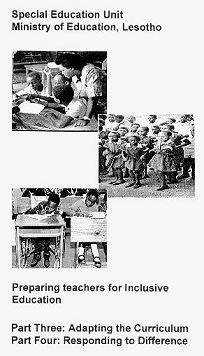Preparing Teachers for Inclusive Education A video package from Lesotho
“This video shows how the capacity of teachers can be built to respond to the needs of disabled children – even in a country with minimal resources.”
Dr Nithi Muthukrishna and her colleague, Mrs Thabi Ntombela, teach in the Department of Education, University of Natal, Durban, South Africa. ‘Diversity in Education’ is the title of one of the courses for the Higher Diploma in Education. This is a one-year post-graduate course for new teachers. ‘Special Needs in Education’ is taught as part of the post-graduate BEd and MEd degree courses for practising teachers. Here Nithi is interviewed by EENET about the usefulness of the Lesotho video for their teaching.
How did you hear about the Lesotho video package?
I heard about it from Roy McConkey. He produced the package with Lineo Phachaka, the Head of the Special Education Unit in Lesotho, and Lilian Mariga, SCF’s adviser to the Ministry of Education on special and inclusive education.
How useful is the video in your work in teacher education?
We have found it extremely valuable because it reflects the practice of inclusive education in a context similar to South Africa. The most important aspect of the Lesotho experience is that it highlights the role that can be played by teachers and school management (our students!) in the whole process – not only in developing inclusive schools, but also inclusive communities. It also provides insight into how teachers and school managers can initiate school-based teacher development programmes.
Do you have other video material for your teaching?
One of the problems we have had over the years is the lack of literature and training materials coming from countries of the South. All other video materials were from the USA, the UK, Canada, Australia and New Zealand. They reflect highly specialized and costly models of service provision and support, and a dependence on specialists to meet the needs of disabled children. Their contexts are so far removed from the challenges we face. In South Africa, 90% of disabled children, especially those in rural areas, have no access to education. The small number of high cost special schools, situated mainly in urban areas, do not meet the needs of the majority of disabled children. An urgent priority is to provide an education for these out-of-school children, and find innovative ways to bring them into the system.
“The video is a rich resource that can be used in school-based initiatives.”
What have you learnt most from the video?
The video shows the whole process of developing inclusive schools. A feasibility study; developing training materials; pilot schools; disability awareness; and developing an awareness of the new policy. It shows how teachers can increase participation in, and minimize exclusion from, the curriculum. It also shows how they can be trained in the following skills: early identification, curriculum adaptation, braille, sign language and the empowerment of parents to help disabled children. The teachers’ stories are extremely valuable.
The transformation of an education system was initiated by a small number of committed individuals with very limited financial resources. They have moved away from the expert model of service provision and made optimum use of existing resources, such as special schools. The importance of developing a shared vision by all stakeholders is highlighted in the video. The human resources within the community are utilised and there is collaboration between parents, teachers, special schools, disabled peoples organisations, universities, colleges of education, NGOs, representatives from Health and Welfare. I was particularly impressed by the way the colleges of education and universities were made part of the process – and how their involvement led to curriculum transformation in teacher education. Our students are most impressed by the empowered African women speaking with such conviction about their own experience.

Lesotho is your neighbour – an independent country within South Africa. Is there any collaboration between the University of Natal and the IE programme in Lesotho?
There is no formal collaboration, but we invited Lilian Mariga and Lineo Phachaka to present at a recent workshop We have begun a pilot programme called “Developing Sustainable Inclusive Policy and Practice”. This is linked to a 3-year collaborative research project involving inclusive schools in India, Brazil and UK. In March 1999 we organised a one-week workshop for 23 schools in a rural district of Kwazulu-Natal. It was attended by one teacher and the principal from each of the schools. Our model of inclusion, which is indigenous and community-based, addresses all barriers to learning and development that result in the exclusion of learners from the culture and curriculum of the school. Disability is one of the issues that will be addressed since the majority of learners with disabilities in this rural context have no access to education.
Would you recommend the video to others?
Yes – everyone involved in inclusive education should have one.
(NOTE: Due to the age of this article, these contact details may no longer work.) Nithi Muthukrishna can be contacted at: Department of Education, University of Natal, Postbag x10, Dalbridge, 4014, Durban, South Africa.
Email: Muthakri@mtb.und.ac.za
“Preparing Teachers for Inclusive Education” is available from EENET at a price of £30.00 for North-based and North-funded organisations. Contributions in kind are welcome from Southern organisations. You could send us some of your training materials in exchange for the video package. The manual is available here on the web site.
(Note: the Lesotho videos are now available on our YouTube channel. We no longer provide VHS tape versions. Given their age, please watch and use the videos with caution – some aspects of them are outdated.)
